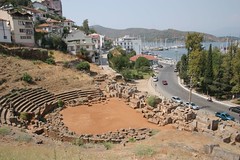Ruins of Telmessos
A trip to Turkey's south coast isn't complete without exploring ancient ruins and archaelogical sites. Fethiye is built upon the ruins of the ancient city of Telmessos and posesses, as remnants of its past, some impressive rock tombs and a recently excavated Hellenistic theatre. However, the majority of the ruins remain still buried under the quaint town.
The town got its name from Telmessos, the son of the god Apollo. Little is known about the origins of Telmessos except that originally it wasn't part of the Lycian Federation. In 4th century BC the Lycians fought against the Telmessians and finally subdued Telmessos and brought it into the Lycian federation. Later Telmessos was captured by Alexander, became part of the kingdom of Pergamum, and during the Roman imperial era the city was part of the Lycian Federation.
The city continued its existence into the Byzantine era, but gradually lost its significance due to the Arab raids. In the 8th century the city's name was changed to Anastasiopolis in honor of a Byzantine emperor and the following century it changed again to "Makri", meaning "Far (City)". Under Ottoman rule this was changed to "Megri" and finally, after the expulsion of the predominantly Greek population in the 1930's, it was named Fethiye after Tayyareci Fethi Bey, a local who was among Turkey's first pilots and also a war hero .
Fethiye suffered two immense earthquakes in 1857 and 1957 which toppled much of the town and completely destroyed the medieval town and the remains from antiquity. Throughout Fethiye, there are the scattered typical Lycian stone sarcophagi dating from around 450 BC. At the main quay at Liman Caddesi there is the the theatre that was excavated only since 1994. It had a capacity of 5,000 people and was built in the Early Roman period and renovated in the 2nd century AD.
The town got its name from Telmessos, the son of the god Apollo. Little is known about the origins of Telmessos except that originally it wasn't part of the Lycian Federation. In 4th century BC the Lycians fought against the Telmessians and finally subdued Telmessos and brought it into the Lycian federation. Later Telmessos was captured by Alexander, became part of the kingdom of Pergamum, and during the Roman imperial era the city was part of the Lycian Federation.
The city continued its existence into the Byzantine era, but gradually lost its significance due to the Arab raids. In the 8th century the city's name was changed to Anastasiopolis in honor of a Byzantine emperor and the following century it changed again to "Makri", meaning "Far (City)". Under Ottoman rule this was changed to "Megri" and finally, after the expulsion of the predominantly Greek population in the 1930's, it was named Fethiye after Tayyareci Fethi Bey, a local who was among Turkey's first pilots and also a war hero .
Fethiye suffered two immense earthquakes in 1857 and 1957 which toppled much of the town and completely destroyed the medieval town and the remains from antiquity. Throughout Fethiye, there are the scattered typical Lycian stone sarcophagi dating from around 450 BC. At the main quay at Liman Caddesi there is the the theatre that was excavated only since 1994. It had a capacity of 5,000 people and was built in the Early Roman period and renovated in the 2nd century AD.











0 comments:
Post a Comment